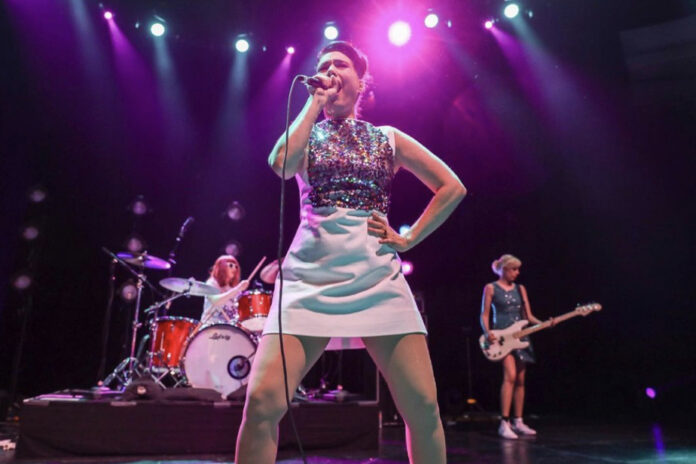It was an accumulation of frustrations and a thirst for speaking out that motivated, in the early 1990s, groups of girls to come together to make music and denounce many injustices. Their goal: “to make feminism more punk, and punk more feminist”. And, by the way, to prove that this musical genre has nothing to do with men.
“What’s interesting about Riot Grrrl is that it’s a protest movement that has come to life within a musical genre,” says musicologist Catherine Harrison-Boisvert. “The Riot Grrrls said, ‘It’s all well and good, punk and its revolutionary aspirations, but there are blind spots and one of those blind spots is sexism.’ »
“Music has the ability to effectively articulate discourse and to focus and catalyze strong collective emotions. This allows him to facilitate the circulation of protest ideas. It echoes feelings of revolt and militant energy and contributes to the creation and consolidation of a community,” continues Catherine Harrison-Boiverst, doctoral student at the University of Montreal.
During the Riot Grrrls era, women described the punk scene as “violent” and multiplied the unpleasant experiences at concerts. Through zines, small craft publications (manifestos) and self-published, tongues are loosened and activists rally. They tell how they are relegated to the back of performance halls and never taken seriously through texts and collages that are committed, sometimes ironic. One of the first Riot Grrrl zines to emerge was called Bikini Kill.
It was during the first shows organized by Kathleen Hanna and her band in Washington that the slogan “girls in the front” would be heard for the first time. “The fact that women are the heart of the mosh pit is in the very DNA of the movement,” says Manon Labry, PhD in North American Civilization and author of Riot Grrrls: Chronicle of a Feminist Punk Revolution.
With more than 20 years of experience in the Quebec underground music scene, Rox Arcand recognizes in these claims what animated her in her beginnings and still animates her.
The musician from the Old Capital has formed her first all-female band… thanks to an announcement on the LesPacs website!
When she began to play with teammates, at the turn of the 2000s in a room rented from Laval University, the looks were heavy with meaning. “We saw the guys who practiced in the other premises looking askance at us. They wondered who we were, what were we doing there. It was striking, ”recalls the one who was part of the groups Molly’s Decline and Machinegun Suzie, among others.
Same story with Catherine Jeanne-D’Arc, who leads the feminist group Charôgne. “I still dress sexy in my shows. Let’s say we’re at the Quai des Mists, dudes will see me from behind through the window and it’ll pique their curiosity so they’ll go home. But they don’t know that I’m yelling at them in my tunes, ”says the queer artist, a smirk.
The group formed in Montreal almost 10 years ago started out playing covers of iconic songs from the Riot Grrrl movement, then eventually diverged into original pieces. Bands like Bikini Kill, L7 and Le Tigre – another Kathleen Hanna band that will be reuniting for a summer reunion tour – have greatly inspired Charôgne’s style.
Like Kathleen Hanna, Catherine Jeanne-D’Arc sometimes writes insults about her body during concerts and likes to provoke less informed audiences.
According to Lyse Ross, a member of the Montreal collective Les Insoumises, the Riot Grrrls demonstrated something important: women and people of sexual diversity need to communicate together. “It can be isolating not having a megaphone to communicate your frustrations, to testify to your reality,” explains the one whose group is on a mission to promote feminist punk culture. “Zines were exactly that, a medium to reach people who are experiencing the same injustices as you, with the ultimate goal of coming together and organizing. »
“It paved the way for a lot of contemporary female musicians. Just the fact that bands like Bikini Kill are reuniting today shows there’s still relevance to that message. I think it’s going to look for something deep, way beyond nostalgia,” says Catherine Harrison-Boisvert.
“When you reread the Riot Grrrl manifesto published in 1991 in the zine Bikini Kill, it’s disturbing, even uneasy, how topical it is,” observes Manon Labry, author and doctor of North American civilization.
The reversal of Roe v. Wade by the US Supreme Court in 2022 is, in her view, a glaring demonstration of this. In 1992, demonstrations by opponents multiplied in front of abortion clinics, forcing certain establishments to close, questioning access to voluntary termination of pregnancy. “There were a lot of marches in Washington and across the country to denounce this, which fueled the desire to fight of these feminist musicians, of which this was one of the demands, she explains. The zines, the music, they were vehicles to testify to their experiences, which did not interest the mass media. »
In Russia, the leader of Pussy Riot, Nadia Tolokonnikova, finds herself on the list of the most wanted criminals. The Russian punk collective, whose name is derived from the Riot Grrrl movement, is one of the most important voices rising against President Vladimir Putin. Another observation that feminist and protest groups still have a political role to play.















